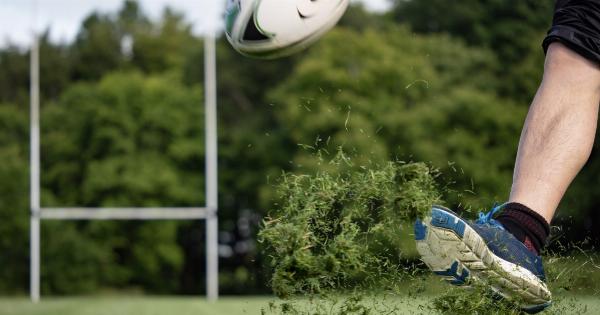Running is a popular form of exercise that provides numerous health benefits. It strengthens the cardiovascular system, boosts metabolism, and improves mental well-being. However, running can sometimes lead to injuries and discomfort.
A wide range of factors can contribute to running-related pain, including improper form, overuse, and wearing incorrect footwear.
Understanding Running Injuries
Running injuries can affect all parts of the body. From head to toe, various regions can experience pain due to the high-impact nature of this activity. Common running injuries include:.
1. Plantar Fasciitis
Plantar fasciitis is a condition that leads to pain along the bottom of the foot, primarily affecting the heel. It is the result of inflammation of the plantar fascia, a thick band of tissue that connects the heel bone to the toes.
Runners with plantar fasciitis often experience sharp, stabbing pain that worsens with the first few steps in the morning.
2. Shin Splints
Shin splints cause pain along the inner edge of the shinbone, or tibia. This condition often occurs when the muscles and tendons surrounding the shinbone become overworked, leading to inflammation.
Runners with shin splints experience throbbing or aching pain that is usually relieved with rest.
3. IT Band Syndrome
IT band syndrome is characterized by pain and tightness on the outside of the knee. The iliotibial (IT) band is a thick band of tissue that runs from the hip to the shinbone.
When it becomes inflamed, runners may experience sharp or burning pain on the outer side of the knee joint.
4. Runner’s Knee
Runner’s knee, also known as patellofemoral pain syndrome, causes pain around or behind the kneecap. It is a common condition among runners and often stems from muscle imbalances, alignment issues, or overuse.
Runners with this condition may experience a dull, aching pain that worsens during activities that require knee bending, such as running downhill or descending stairs.
5. Achilles Tendinitis
Achilles tendinitis is characterized by pain and stiffness in the Achilles tendon, which connects the calf muscles to the heel bone. It usually occurs due to repetitive stress or overuse.
Runners with Achilles tendinitis experience pain that worsens with physical activity and may improve with rest.
Diagnosing Running-Related Pain
When running-related pain arises, it is crucial to identify the underlying cause to prevent worsening of the condition and promote proper healing. A thorough diagnostic process helps determine the appropriate treatment plan.
The following are common methods used to diagnose running-related pain:.
1. Physical Examination
A physical examination conducted by a healthcare professional helps assess the affected area and identify potential causes of the pain. Range of motion, stability, and strength are evaluated to pinpoint the areas of weakness or any abnormalities.
2. Medical History
Gathering a comprehensive medical history provides valuable insights into the individual’s overall health and any pre-existing conditions that may contribute to the running-related pain.
Understanding previous injuries, surgeries, and chronic conditions aids in diagnosis and treatment planning.
3. Imaging Tests
In certain cases, imaging tests such as X-rays, ultrasounds, or magnetic resonance imaging (MRI) scans may be ordered. These tests help visualize the bone structures, soft tissues, and potential abnormalities, providing a more accurate diagnosis.
4. Gait Analysis
Gait analysis involves observing an individual’s running or walking pattern. It helps determine any structural or biomechanical issues that may contribute to the running-related pain.
A gait analysis may include video recordings, foot pressure measurements, and observing the alignment of various body parts during movement.
5. Blood Tests
In some cases, blood tests may be conducted to rule out certain medical conditions, such as autoimmune disorders or infections, which could be contributing to the running-related pain.
Treatment Options
Once a running-related injury has been accurately diagnosed, appropriate treatment options can be explored. The choice of treatment depends on the specific condition and the severity of the injury. Treatment options for running-related pain include:.
1. Rest and Ice
Rest is crucial to allow the body to heal. Ice can help reduce swelling and relieve pain. Applying ice to the affected area for 15-20 minutes several times a day can help alleviate symptoms.
2. Physical Therapy
Physical therapy plays a vital role in the recovery process. It includes exercises and stretches targeting the affected area, strengthening exercises to correct muscle imbalances, and techniques to improve mobility and flexibility.
Physical therapists also educate runners about proper form, footwear choices, and training techniques to prevent future injuries.
3. Medication
Nonsteroidal anti-inflammatory drugs (NSAIDs) can provide temporary relief from pain and reduce inflammation.
However, it is important to consult with a healthcare professional before taking any medication, as they may have side effects and interact with other medications.
4. Orthotics and Supportive Footwear
Orthotic inserts and supportive footwear can help correct gait abnormalities, distribute pressure evenly, and provide additional support to prevent further injury.
A podiatrist or orthopedic specialist can recommend appropriate orthotics or shoes based on individual needs.
5. Surgical Intervention
In severe cases where other treatments have failed, surgical intervention may be necessary. This option is typically reserved for injuries that significantly impact the individual’s daily activities or athletic performance.
Preventing Running-Related Pain
Prevention is key when it comes to running-related pain. By taking proactive measures, runners can significantly reduce the risk of injury and discomfort. Here are some essential preventive strategies:.
1. Gradual Progression
Start running at a comfortable pace and gradually increase intensity, duration, and distance. This allows the body to adapt and minimizes the risk of overuse injuries.
2. Proper Warm-up and Cool-down
Warm-up exercises prepare the muscles for the physical demands of running, reducing the chances of strains or tears. Similarly, a cool-down routine with stretching helps prevent stiffness and promotes muscle recovery.
3. Cross-Training
Engaging in cross-training activities such as swimming, cycling, or strength training helps strengthen different muscle groups and prevents overuse injuries. It also provides a break from the repetitive impact of running.
4. Listen to Your Body
Pay attention to any warning signs, such as persistent pain or discomfort. Ignoring these signs can lead to worsening of the condition. If something feels off, take a break and seek medical advice if needed.
5. Proper Footwear
Invest in good-quality running shoes that provide adequate support, cushioning, and stability. Replace shoes regularly to ensure they are still providing proper shock absorption and support.
Conclusion
Running is a fantastic form of exercise, but it can lead to various injuries and pain if not approached with caution.
Understanding the different types of running-related injuries and their causes is essential for early diagnosis and effective treatment. By taking appropriate measures to prevent running-related pain, runners can continue to enjoy the numerous health benefits associated with this popular activity.




























